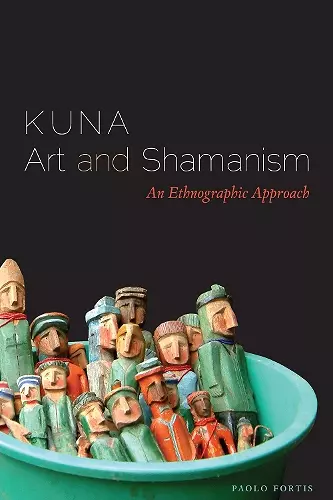Kuna Art and Shamanism
An Ethnographic Approach
Format:Paperback
Publisher:University of Texas Press
Published:1st Dec '13
Currently unavailable, and unfortunately no date known when it will be back

"Paolo Fortis carves out a new topic of study of the Kuna world that is of significance and has never been studied this way before... His ethnography is excellent, and the vivid discussions of the relationship between the invisible spirit world and the visible human, animal, and plant world are particularly well done." -- Joel Sherzer, Professor Emeritus of Anthropology and Linguistics, University of Texas at Austin "The subject matter is fascinating... Beyond the field of cultural anthropology, I believe the book will be of considerable interest to cognitive psychologists, especially those specializing in theory of mind." -- Philip D. Young, Professor Emeritus of Anthropology, University of Oregon
The first book to study woodcarving and its relation to shamanism among Kuna people from the San Blas Archipelago, providing a rich new lens for understanding the Kuna worldview.
Known for their beautiful textile art, the Kuna of Panama have been scrutinized by anthropologists for decades. Perhaps surprisingly, this scrutiny has overlooked the magnificent Kuna craft of nuchukana—wooden anthropomorphic carvings—which play vital roles in curing and other Kuna rituals. Drawing on long-term fieldwork, Paolo Fortis at last brings to light this crucial cultural facet, illuminating not only Kuna aesthetics and art production but also their relation to wider social and cosmological concerns.
Exploring an art form that informs birth and death, personhood, the dream world, the natural world, religion, gender roles, and ecology, Kuna Art and Shamanism provides a rich understanding of this society’s visual system, and the ways in which these groundbreaking ethnographic findings can enhance Amerindian scholarship overall. Fortis also explores the fact that to ask what it means for the Kuna people to carve the figure of a person is to pose a riddle about the culture’s complete concept of knowing.
Also incorporating notions of landscape (islands, gardens, and ancient trees) as well as cycles of life, including the influence of illness, Fortis places the statues at the center of a network of social relationships that entangle people with nonhuman entities. As an activity carried out by skilled elderly men, who possess embodied knowledge of lifelong transformations, the carving process is one that mediates mortal worlds with those of immortal primordial spirits. Kuna Art and Shamanism immerses readers in this sense of unity and opposition between soul and body, internal forms and external appearances, and image and design.
The final product is a rich ethnographic consideration of Kuna conceptual life with a focus on Kuna personhood. * Choice *
ISBN: 9780292756861
Dimensions: 229mm x 152mm x 18mm
Weight: 313g
271 pages